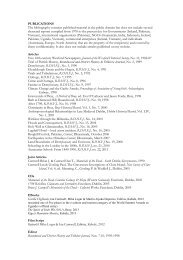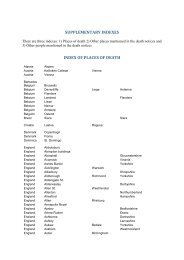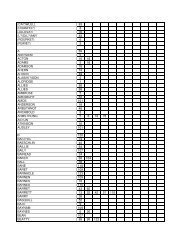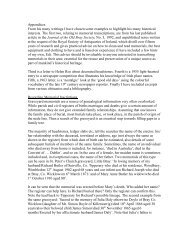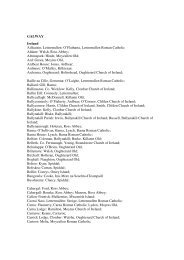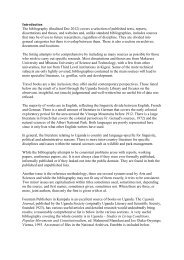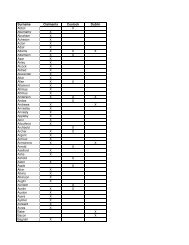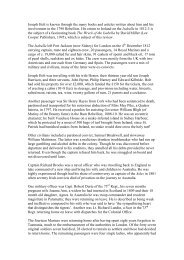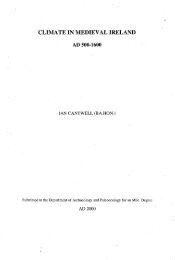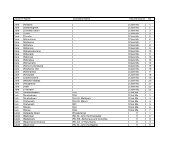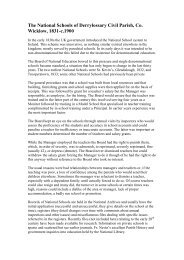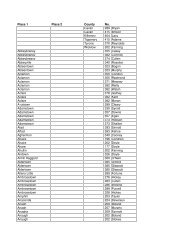4,6Q0-4,200BP, with an increase of sphagnum from around 2,800BP. Secondarydeposition in the lake start to appear from around 3,000 BP. This is believed to be as aresult of banks reaching critical depth and/or the composition of different peat typesbecoming unstable on slopes. Wet seasons would also enhance the possibility of bogflows and one is recorded at SliabhCualannin 867 19 . The authors further note that theformation and erosion ofpeat has been significant in the last 150years.20NeolithieFrom about 4,800-4,700 BP (2,800-2,700 BC) the distribution of tree cover changeswith a growth in oak and birch but a declinein hazel (substituted by holly), alder, pine(substituted by yew) and the appearance ofash. For the first time charcoalvalues showa large increase beyond natural causes and indicates the first human presence in thevalley. Tree pollen values decline and is followed by an increase in grasses. In this. period the species range becomes more cyclical which indicates human disturbance byNeolithic Pastoral farming. Open ground species such as grasses (Pooceae), plantain(p/antego lanceo/. t.), sedges (Cyperaceae), nettle (UTtica), heather (Ca/luna) andferns become more common. The growth of heather also indicates the first spread ofblanket bog whichbecame widespreadfrom 4,500 BP (2,500 Be).It bas been oftennoted that the eastern uplands has much less archaeological evidencethan the north west with its rich heritage oftombs and settlement sites 21 . Ritual sitessuch as Megalithictombs (with a possible kerbed cairn) are to be found in Parkmore2 2and Glasnamullen2 3 . Cooney24 has pointed out the spatial relationship between19CantweU I. Climate Change andtheGaelicAnnals,Proceedingsofthe YOJIng IrishArchaeologists,Galway, 199&, p. 3120aradshaw R W.R. &.McGee E., The extent. andtime-course ofmountain blanket erosioninIreland,New Phytologist, Vol. 18, 1988, pp. 221-421ibid., p. 1, & quoting Price Liam, The ages of stone andbronze in Co. Wicldow, R.IA. Proc., xlii,sect. C, 1934, pp. 31-6422GroganEoin andKiIfeather Aone, ArchaeologicalInventory o/County Wick/ow, Dublin, 1997; p. 8&2123SIOut, op cit p. 3224Cooncy Gabriel, Megalithic tombs in their environmental setting: a settlement perspective,IS
settlement and the ritual landscape which is obvious in the GlasnamuUen area withsettlement on the plateau and tombs on Djouce mountain (725m). The ritualsignificance ofParkmore is unclear though they do stand at a cross-roads. Withinthearea the archaeological indications are that Ballyremon Commons, PowerscourtPaddock and Glasnamullen have been continuously settled from at least the late thirdmillennium Be onwards and were probably the centres of settlement until at least1200AD.25It must be stressed that all interpretations ofthe area's prehistory are based on surveysof surviving surface sites and that the area has had hardly any archaeologicalexcavation. The concentrationofsettlement in the northern part ofthe plateau, situatedon passes from the northern and eastern lowlands is likely to be significant. The lack ofsites from the Glendalough valley may be a function of the intense landscapemanagement from the early Christianperiod. In general the area is poorly representedby archaeological remains.Early settlement probablywas basedon the shifting model oflandscape clearance andabandonment within forest clearings followed by later more permanent settlement onthe plateau based in northern higher sections 26 . A major clearance phase ofoak, birchand alder appears in about 3,.500 BP (1,.500 Be) and this cuhninates in the firstappearance ofcereal pollen (Triticum) about 200 years later. Charcoal values show asharp rise around this time. Cereal planting was probably on the lighter soils ofmoraines above the lakes with cycles of clearance and abandonment happening at afaster rate. This late date of cereal farming, approximately 1,500 years after its firstrecorded appearanee27~is perhaps typical ofupland areas and this expansion is maybeLandscapeArchaeologyin Ire/and. R:eeves-Smyth Terence & Hamond Fred, London, 1984, p. 183~5250ropn OIl.cit. p. 244 for map26AalenF.RA, ManlJlldthe landscape in Ireland, London, 1978,p. 6527Edwards K.J., The Anthropogenic factor in vegatational history, Quatemary Ireland. eel. EdwardsKIlt WarrenW.P.,London, 1985,pp. 196-716
- Page 1 and 2: SOCIETY AND SETTLEMENTINGLENDALOUGH
- Page 3: INTRODUCTIONIn 1990, due to family
- Page 6 and 7: "Geography is a permanentfactor in
- Page 8 and 9: ACKNOWLEDGEMENTSI am deeply indebte
- Page 10 and 11: MEmODOLOGYIn 1996 two important wor
- Page 12 and 13: The fourth was the primary research
- Page 14 and 15: have been a tributary of the Avonmo
- Page 16 and 17: Pre-HoloceneAt the end of the perio
- Page 20 and 21: diagnostic ofhigh population pressu
- Page 22 and 23: Map2 Pre-Historic archaeology~. ._
- Page 24 and 25: must be careful in interpreting the
- Page 26 and 27: may be Downemore in Glassnamullen b
- Page 28 and 29: Knockadreet (Cnoc a' droichead); th
- Page 30 and 31: What is worth noting is the continu
- Page 32 and 33: include the creation ofa saintly ar
- Page 34 and 35: v1ap 4 Diffusion ofSelected Saints:
- Page 36 and 37: From around the ninth century Giend
- Page 38 and 39: Glendalough: Politieal contextDurin
- Page 40 and 41: understanding medieval ideologies,
- Page 42 and 43: Glendalough: Abbey and BishoprieIn
- Page 44 and 45: low density which he explains by th
- Page 46 and 47: known how well this represents cont
- Page 48 and 49: Parish of Glendalough in the 1821.
- Page 50 and 51: What is unclear is the amount of un
- Page 53 and 54: The charters ofconfirmation to the
- Page 55 and 56: Dublin, John Cumin, was in exile 11
- Page 57 and 58: must pay for the wood 209 . This gr
- Page 59 and 60: appears to be the continuation ofth
- Page 61 and 62: 'IIIRoad to Plateau,,-- --Map 8 Cas
- Page 63 and 64: ecame Archdeacon of Glendalough and
- Page 65 and 66: obscure and even the great expert,
- Page 67 and 68: Glassnamullen was hived offfrom the
- Page 69 and 70:
CHAPTER 4CONQUESTANDSECULMUSATIONPo
- Page 71 and 72:
Glenmalure, but the fact that descr
- Page 73 and 74:
I Map 9 Politics and Conquest - 130
- Page 75 and 76:
Castlekevin under siegeThe impact o
- Page 77 and 78:
transition from grain to pastoral a
- Page 79 and 80:
CHAPTERSDECLINE, RESURGENCE AND EXT
- Page 81 and 82:
Resurgence - The political backgrou
- Page 83 and 84:
ofthe lowlandsofthe Pale andthe ber
- Page 85 and 86:
which were put into execution in th
- Page 87 and 88:
succumbed to the Gaelic Dream when
- Page 89 and 90:
year. However it was agreed and con
- Page 91 and 92:
Whigmanstown, Glasmollin and Tollag
- Page 93 and 94:
By 1636 there is a well utilised la
- Page 95 and 96:
integration into English and Europe
- Page 97 and 98:
SettlementThe Hearth Money Rolls of
- Page 99 and 100:
can be organised differently to a s
- Page 101 and 102:
Over the period there are various p
- Page 103 and 104:
APPENDIXlPOLLEN RESEARCH IN GLENDAL
- Page 105 and 106:
Notwithstanding the problems ofinte
- Page 107 and 108:
Glendalough, Co. Wicl\lowPoll en Pe
- Page 109 and 110:
CALIBRATION OF RADIOCARBOAGE TO CAL
- Page 111 and 112:
advantage to be able to return to t
- Page 113 and 114:
eformers such as LanfrancofPavia an
- Page 115 and 116:
His canonisation is an excellent ex
- Page 117 and 118:
In conclusion the history ofthe Chu
- Page 119 and 120:
Castlekevin LineArtOge----------1--
- Page 121 and 122:
Inquisition at Castle Keuyn. 1257-6
- Page 123 and 124:
I went to view.the lands of the Var
- Page 125 and 126:
In the Study area the main element
- Page 127 and 128:
ABBREVIATIONSAlen'sReg.: Calendarof
- Page 129 and 130:
Cantwell Ian, DiamondHill, RD.H.F.J
- Page 131 and 132:
Long Harry, Three Settlements ofGae
- Page 133 and 134:
Smyth AlfredP., Kings, Saintsand Sa



